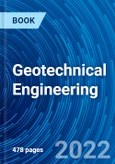Geotechnical engineering defines soil properties and strength, as well as the mechanics of soil and rocks. It involves other important earth materials like snow, clay, slit and sand. This discipline focuses on the use of scientific methods and engineering principles to interpret the characteristics of the ground to determine suitability for building and construction.
This book serves as a textbook for undergraduate students in Civil Engineering, Mining Engineering, and Engineering Geology. It is written in line with the model syllabus prescribed by All India Council for Technical Education. The book will be equally useful to candidates appearing for competitive examinations and for practising engineers.
This book serves as a textbook for undergraduate students in Civil Engineering, Mining Engineering, and Engineering Geology. It is written in line with the model syllabus prescribed by All India Council for Technical Education. The book will be equally useful to candidates appearing for competitive examinations and for practising engineers.
Audience Includes:
- B.E. & B.Tech student of Civil Engineering, Mining Engineering and Geotechnical Engineering
Table of Contents
1. Introduction to Soil Mechanics2. Basic Soil Properties
3. Plasticity Characteristics of Soil
4. Classification of Soil
5. Permeability and Seepage
6. Effective Stress Principle
7. Compaction of Soil
8. Stresses in Soil
9. Consolidation of Soil
10. Shear Strength of Soil
11. Stability of Slopes
12. Introduction to Soil Exploration
Practical Work








